中级财务会计(双语)第二章
中级财务会计英文ch13117页PPT
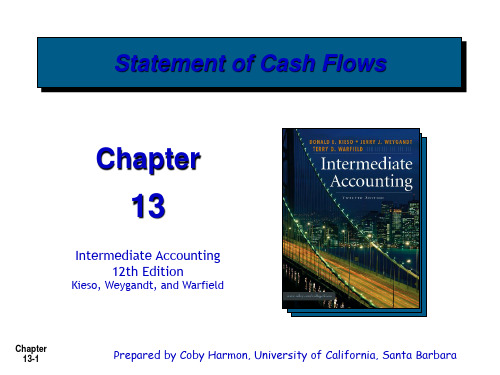
Inflows
Proceeds from plant assets sales
Proceeds from sales and maturities of debt and equity securities
Collections of loan principal Sale of real estate
- Incurrence of capitalized lease obligations. SFAS No. 95 provides no guidance with regard to stock
dividends or stock splits.
Chapter 13-15
Direct Method Under the direct method, a
Cash Flows from Investing Activities
Cash Flows from Financing Activities
Chapter 13-10
Cash From Operating Activities
Inflows
Receipts from customers Interest received Dividends received Refunds from suppliers Revenues received in
Outflows
Payments to purchase plant assets
Purchases of debt and equity securities
Loans to others Payments to purchase real
estate
Chapter 13-12
Cash Flows From Financing Activities
中级财务会计英文ch04-文档资料

Cash
Overdraft
Negative bank account balance reported as a current liability.
Compensating balance
Minimum balance that must be maintained in a company’s account as support for funds borrowed from the bank.
Travel Expenses Customer Business Lunches Express Mail Postage Miscellaneous Office Supplies
$79.30 93.42 55.00 32.48
Prepare the journal entry to record replenishing fund if the balance on July 31 was $137.80.
中级财务会计英文ch04-文档资料
点击此处可添加副标题
Cash and Receivables
Chapter
4
Intermediate Accounting 12th Edition
Kieso, Weygandt, and Warfield
Chapter 4-2
Prepared by Coby Harmon, University of California, Santa Barbara
balances. Permit reconciliation of ledger and bank cash
account balances. Result in the physical control of cash.
财务会计英语第2章译文
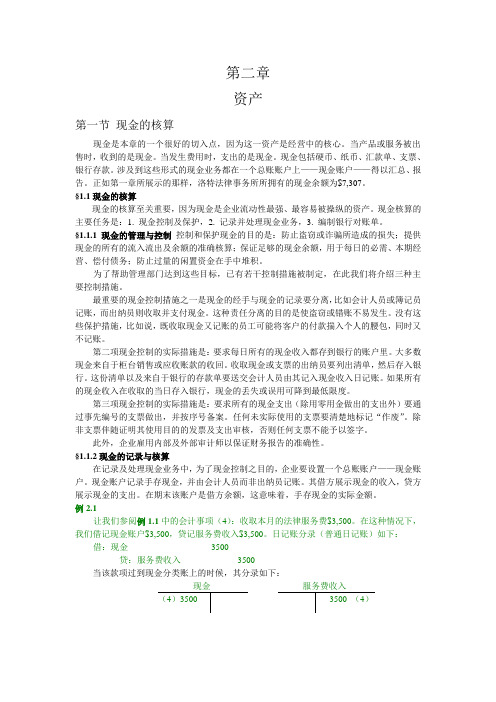
第二章资产第一节现金的核算现金是本章的一个很好的切入点,因为这一资产是经营中的核心。
当产品或服务被出售时,收到的是现金。
当发生费用时,支出的是现金。
现金包括硬币、纸币、汇款单、支票、银行存款。
涉及到这些形式的现金业务都在一个总账账户上——现金账户——得以汇总、报告。
正如第一章所展示的那样,洛特法律事务所所拥有的现金余额为$7,307。
§1.1现金的核算现金的核算至关重要,因为现金是企业流动性最强、最容易被操纵的资产。
现金核算的主要任务是:1. 现金控制及保护,2. 记录并处理现金业务,3. 编制银行对账单。
§1.1.1现金的管理与控制控制和保护现金的目的是:防止盗窃或诈骗所造成的损失;提供现金的所有的流入流出及余额的准确核算;保证足够的现金余额,用于每日的必需、本期经营、偿付债务;防止过量的闲置资金在手中堆积。
为了帮助管理部门达到这些目标,已有若干控制措施被制定,在此我们将介绍三种主要控制措施。
最重要的现金控制措施之一是现金的经手与现金的记录要分离,比如会计人员或簿记员记账,而出纳员则收取并支付现金。
这种责任分离的目的是使盗窃或错账不易发生。
没有这些保护措施,比如说,既收取现金又记账的员工可能将客户的付款揣入个人的腰包,同时又不记账。
第二项现金控制的实际措施是:要求每日所有的现金收入都存到银行的账户里。
大多数现金来自于柜台销售或应收账款的收回。
收取现金或支票的出纳员要列出清单,然后存入银行。
这份清单以及来自于银行的存款单要送交会计人员由其记入现金收入日记账。
如果所有的现金收入在收取的当日存入银行,现金的丢失或误用可降到最低限度。
第三项现金控制的实际措施是:要求所有的现金支出(除用零用金做出的支出外)要通过事先编号的支票做出,并按序号备案。
任何未实际使用的支票要清楚地标记“作废”。
除非支票伴随证明其使用目的的发票及支出审核,否则任何支票不能予以签字。
此外,企业雇用内部及外部审计师以保证财务报告的准确性。
中级财务会计英文ch03
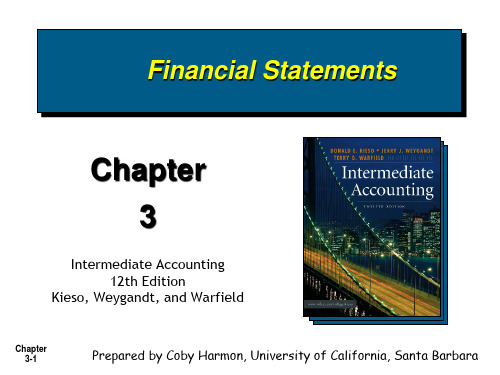
Investments and funds
Intangibles
Noncurrent Assets
Property, Plant, & Equipment
Chapter 3-10
Deferred Charges
Balance Sheet Format
Liability Classifications
Under this concept, corporate income for a period of time is the amount that may be paid to stockholders during that period and still enable the corporation to be as well off at the end of the
Chapter 3-16
Statement of Changes in Stockholders’ Equity
SCHEDULE A CARON MANUFACTURING COMPANY
Statement of Changes in Stockholders’ Equity
For Year Ended December 31, 2007
diesqtruiibtyutaioccnosutnotowwhneenrsisdsuuriningg the pefirnioadn,caiaml ostnagteomtheenrtsi.tems.
Chapter 3-15
Statement of Changes in Stockholders’ Equity
statement. 11. Compute income from continuing operations. 12. Compute results from discontinued operations. 13. Identify extraordinary items. 14. Prepare a statement of retained earnings. 15. Report comprehensive income.
中级财务会计英文课件Accouting_Principles-----Financial_Accounting

Hiring an employee
Do not record
Paying an employee
Record
ECONOMIC ENTITYASSUMPTION
BMW
The activities of the
entity are to be kept
separate and distinct
from the activities
STUDY OBJECTIVE 1
GAAP & CONCEPTUAL FRAMEWORK
GAAP is a set of standards and rules recognized as a general guide for financial reporting supported by:
SEC
Benz
of the owner and all
other economic entities.
Economic events can be identified with a particular unit of accountability
TIME PERIOD ASSUMPTION
The economic life of a business can be divided into artificial time periods
Apooft isnatle
Costs
Matching
Matching
Materials
Sales Revenue
During production
At time cash received
Labor
Revenue should be recognized in the accounting period in which it is earned (generally at point of sale).
2012中级财务会计第二章英文版课件FA02Conceptual Framework Underlying Financial Accounting
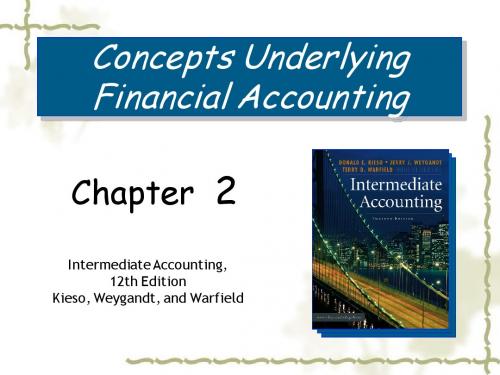
Third 3.Industry pracБайду номын сангаасice level
4.Full disclosure
4.Conservatism ELEMENTS
QUALITATIVE CHARACTERISTICS Relevance Reliability Comparability Consistency
Assets, Liabilities, and Equity Investments by owners Distribution to owners Comprehensive income Revenues and Expenses Gains and Losses
Second level
First level
OBJECTIVES
The Framework is comprised of three levels:
First Level: Basic Objectives
Decision usefulness Objectives of Financial reporting are to provide information that is:
“The FASB identified the Qualitative Characteristics of accounting information that distinguish better (more useful) information from inferior (less useful) information for decision-making purposes.”
(a) Useful in investment and credit decisions (b) Useful in assessing future cash flows (c) About enterprise resources, claims to resources, and changes in them
中级财务会计 Chapter 2 Currency Funds

与库存现金的收付业务一样,银行存款的收 付业务也应由出纳人员负责办理。财会部门 应认真执行现金管理办法和结算制度,做好 银行存款的核算工作,随时掌握银行存款的 收支动态和结存情况。
二、支付结算方式
票据 包括:银行汇票 商业汇票 银行本票 支票 信用卡 汇兑 托收承付 委托收款 国际信用证
通过清查发现有库存现金短缺或溢余,在 查明原因之前,应通过“待处理财产损溢” 科目进行核算,待查明原因之后,再根据 不同情况分别进行处理。
“待处理财产损溢” : 核算企业在清查财产过程中查明的各种财产盘盈、 盘亏和毁损的价值,属于资产类科目。借方登记盘 亏的各种财产的价值和结转经过批准处理的盘盈财 产的价值;贷方登记盘盈的各种财产的价值(除固 定资产外。固定资产盘盈作为前期差错,记入“以 前年度损益调整”科目)和结转处理的盘亏财产的 价值。本科目处理前的借方余额,反映企业尚未处 理的各种财产的净损失;处理前的贷方余额,反映 企业尚未处理的各种财产的净溢余。期末处理后本 科目应无余额。
(一) 收入的管理 企业收入的现金应于当日送存银行,当日送 存银行有困难的,由开户银行确定送存时间。
(二) 支出的管理 企业可以在下列范围内使用现金: 1.职工工资、津贴; 2.个人劳动报酬; 3.根据国家规定颁发给个人的科学技术、文 化艺术、体育等各种奖金;
4.各种劳保、福利费用以及国家规定的对个 人的其他支出; 5.向个人收购农副产品和其他物资的价款; 6.出差人员必须随身携带的差旅费; 7.结算起点以下的零星支出; 8.中国人民银行确定需要支付库存现金的其 他支出。
第二节
银行存款 Bank Deposit
一、Management of Bank Deposit (一)银行存款账户的管理 按照中国人民银行颁布的《支付结算办法》 和《银行账户管理办法》的规定,企业应在 银行开立账户,办理存款、取款和转账等结 算。银行存款账户分为基本存款账户、一般 存款账户、临时存款账户和专用存款账户。
中级财务会计—第二章PPT课件

足,申请批准调整
2、日清日结制度
出纳每天清点库存现金,不相符找原因
3、内部审计
内审人员定期检查、随机抽查库存现金
18
LOGO
❖库存现金的会计处理
▪库存现金的收付业务手续
1、库存现金收入业务手续
营业收入现金(收款人、银行、出纳、进账单、核对业务、内部收据)
应收款项收回(差旅费、出纳、清点、账实核对、发票或内部收据、记账凭
库存现金日记账
库存现金清查(定期、不定期、库存现金清查报告)
20
LOGO
❖库存现金的会计处理
▪库存现金的会计处理
1、账务处理
从银行提取现金;差旅费借出;销售运费报销;差旅费报销;业务招待费
2、日记账填写(P22)
3、现金的短缺或溢余
有待查明原因的现金短缺或溢余
盘亏:责任人赔款、保险公司、无法查明
盘盈:多收或少付单位或个人;无法查明原因
LOGO
2
辅导书
可编辑
3
考试大纲
❖ 电大中级财务会计二教学大纲.doc ❖ 中级财务会计(二)范围: 第九章 流动负债——第十四章 财务报表
LOGO
4
❖思考:
▪ 货币资金的范围和其相关的内部控制制度 ▪ 库存现金的管理、会计处理、清查 ▪ 银行存款的管理、会计处理、核对 ▪ 其他货币资金的内容及核算
LOGO
16
❖库存现金的管理与控制
▪库存现金支出控制
严格控制现金使用范围(八种范围P19) 职能分工(采购、出纳、记账分工;支票签发、审核、付款分工) 健全付款手续 加强监督(记录检查,存出款清理核对)
LOGO
17
❖库存现金的管理与控制
▪库存现金的控制
中级财务会计I(双语)课程ch06

More Complex Situations
Present Value Measurement
Deferred annuities
Valuation of long-term bonds
Effectiveinterest method of bond discount/ premium amortization
Illustration 6-1 Simple vs. Compound Interest
Year 1 $10,000.00 x 9% Year 2 $10,900.00 x 9% Year 3 $11,881.00 x 9%
$ 900.00 $ 10,900.00 $ 981.00 $ 11,881.00 $1,069.29 $ 12,950.29
Illustration: KC borrows $20,000 for 3 years at a rate of 7% per year. Compute the total interest to be paid for the 3 years.
Total Interest
Interest = p x i x n = $20,000 x .07 x 3 = $4,200
6-1
CHAPTER 6
ACCOUNTING AND THE TIME VALUE OF MONEY
Intermediate Accounting IFRS Edition
Kieso, Weygandt, and Warfield
6-2
Learning Objectives
1. Identify accounting topics where the time value of money is relevant. 2. Distinguish between simple and compound interest. 3. Use appropriate compound interest tables. 4. Identify variables fundamental to solving interest problems. 5. Solve future and present value of 1 problems. 6. Solve future value of ordinary and annuity due problems. 7. Solve present value of ordinary and annuity due problems. 8. Solve present value problems related to deferred annuities and
中级财务会计学英文课件 (2)

Intermediate Accounting 2 Financial Reporting: Its Conceptual Framework
Conceptual Framework Overview
Objectives of Financial Reporting
Qualitative Characteristics of Accounting Information
Intermediate Accounting 2 Financial Reporting: Its Conceptual Framework
Statements of Financial Accounting Concepts issued by FASB
Concepts Statement No. 3 Elements of Financial Statements of Business Enterprises (Issue Date 12/80, replaced by No. 6 in 1985)
Intermediate Accounting 2 Financial Reporting: Its Conceptual Framework
Functions of FASB Conceptual Framework
To guide the FASB in establishing accounting standards. To provide a frame of reference for resolving accounting questions in situations where a standard does not exist. To determine the bounds for judgment in the preparation of financial statements.
中级财务会计基本术语中英文对照
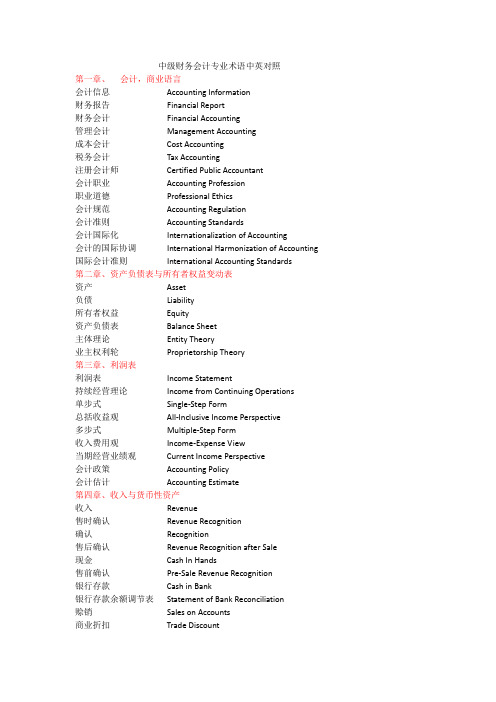
中级财务会计专业术语中英对照第一章、会计,商业语言会计信息Accounting Information财务报告Financial Report财务会计Financial Accounting管理会计Management Accounting成本会计Cost Accounting税务会计Tax Accounting注册会计师Certified Public Accountant会计职业Accounting Profession职业道德Professional Ethics会计规范Accounting Regulation会计准则Accounting Standards会计国际化Internationalization of Accounting会计的国际协调International Harmonization of Accounting 国际会计准则International Accounting Standards第二章、资产负债表与所有者权益变动表资产Asset负债Liability所有者权益Equity资产负债表Balance Sheet主体理论Entity Theory业主权利轮Proprietorship Theory第三章、利润表利润表Income Statement持续经营理论Income from Continuing Operations单步式Single-Step Form总括收益观All-Inclusive Income Perspective多步式Multiple-Step Form收入费用观Income-Expense View当期经营业绩观Current Income Perspective会计政策Accounting Policy会计估计Accounting Estimate第四章、收入与货币性资产收入Revenue售时确认Revenue Recognition确认Recognition售后确认Revenue Recognition after Sale现金Cash In Hands售前确认Pre-Sale Revenue Recognition银行存款Cash in Bank银行存款余额调节表Statement of Bank Reconciliation赊销Sales on Accounts商业折扣Trade Discount现金折扣Cash Discount销售退回与折让Sales Returns and Allowances应收票据Notes Receivable应收账款Accounts Receivable坏账Bad Debt坏账准备Allowance for Doubtful Accounts坏账费用Bad Notes Expense现金等价物Cash Equivalents备抵法Allowance Method直接核销法Specific Write-off Method预付账款Repaid Payment账龄法Aging of Accounts Receivable应收票据贴现Bank Discounting销售百分比法Percentage of Sales Method应收账款百分比法Percentage of Accounts Receivable Method第五章、销售成本与存货存货Inventory销售成本Costs of Goods Sold定期盘存制Periodic Inventory System永续盘存制Perpetual Inventory System个别计价法Specific Identification先进先出法First-in First-out Method ,FIFO后进先出法Last-in First-out Method ,LIFO加权平均法Weight Average Method可变现净值Net Realizable Value移动平均法Moving Weight Average Method稳健性原则Conservatism Principle一致性原则Consistency Principle成本与市价孰低法Lower-of-Cost-or-Market Method ,LCM第六章、长期资产及摊销长期资产Long-Term Asset摊销Amortization资本性支出Capital Expenditure收益性支出income Expenditure固定资产Fixed Assets累计折旧Accumulated Depreciation直线法Straight Line Method加速折旧法Acceleration Depreciation Method双倍余额递减法Double Declining-Balance Depreciation Method 年数总和法Sum-of-The-Years-Digits Method无形资产Intangible Assets研究开发成本Research &Development Costs商誉Goodwill自创商誉Internally Developed Goodwill外购商誉Purchased Goodwill立即注销法Immediate Write-off Method永久保留法Non-Amortization Method系统摊销法Systematical Amortization Method 递耗资产Wasting Assets折耗Depletion递延资产Deferred Assets or Deferred Charges 第七章、长期投资于企业合并投资investment短期投资short-term investment长期投资long-term investment股票投资stock investment债券投资bond investment直线法straight-line method实际利率法effective rate method成本法cost method权益法equity method可转换债券convertible bond企业合并business combination吸收合并merger创立合并consolidation控股合并acquisition of majority interest横向合并horizontal integration纵向合并vertical integration混合合并conglomeration合并财务报表consolidated financial statements购买法purchase method权益结合法pooling of interest method母公司parent company子公司subsidiary company第八章、资本来源:负债负债liabilities流动负债current liabilities长期负债long-term liabilities短期借款short-term bank loans应付票据notes payable带息票据Interest-bearing notes应付账款accounts payable不带息票据noninterest-bearing notes应付工资wages payable增值税value-added tax消费税excise应付公司债券bonds payable信用债券debenture抵押债券mortgage bonds可转换公司债券convertible bonds长期借款long-term loans复利compound interest年金annuity终值future value现值present value本金principle利息interest第九章、资本来源:所有者权益所有者权益owner’s equity实收资本paid-in capital资本公积capital reserve盈余公积surplus from profit独资企业sole proprietorship合伙企业partnership enterprise公司制企业corporate enterprise普通股common share优先股preferred share第十章、特殊会计问题:非货币性资产交换非货币性资产交换non-monetary transaction 非货币性资产non-monetary asset货币性资产monetary asset换入资产swap-in asset换出资产swap-out asset公允价值fair value账面价值book value第十一章、特殊会计问题:债务重组债务重组debt reorganization或有支出contingent payment或有收益contingent gain第十二章、特殊会计问题:或有事项或有事项contingency或有资产contingent asset或有负债contingent liability第十三章、特殊会计问题:关联方关系及交易关联方related party控制control共同控制common control重大影响material influence母公司parent company子公司subsidiary company合营企业joint venture联营企业affiliated enterprise第十四章、企业财务报告----资产负债表与利润表财务报告financial report财务信息financial information第十五章、企业财务报告----现金流量表与所有者和权益变动表现金等价物cash equivalent现金流动表cash flow statement经营活动operating activity投资活动investment activity筹资活动financing activity直接法direct method间接法indirect method工作底稿法working sheet methodT型帐户法T account method第十六章、会计调整会计调整Accounting Adjustment会计政策变更Accounting policy change追溯调整法retrospective application未来适用法prospective application会计估计变更accounting estimate change会计差错更正accounting error correction资产负债表日后事项event occurring after the balance sheet date 调整事项adjustment event非调整事项non-adjustment event第十七章、财务报表分析财务报表分析financial statements analysis结构分析法structural analysis method趋势分析法trend analysis method比率分析法ratio analysis method偿债能力debt repayment ability流动比率current ratio速动比率quick ratio资产负债率liabilities to assets ratio产权比率liabilities to equity ratio有形净值负债率liabilities to tangible assets ratio已获利息倍数interest coverage营运能力operating capacity存货周转率inventory turnover ratio应收账款周转率receivable turnover ratio营业周期operating period总资产周转率assets turnover ratio流动资产周转率current assets turnover ratio盈利能力profitability销售毛利率gross profit ratio销售净利率net income to sales ratio资产净利率rate of return on total assets净资产收益率return on shareholders’ equity权益乘数equity multiplier市场价值market value每股盈余earnings per share, EPS市盈率price earnings ratio股利支付率dividend payout ratio每股净资产net assets per share第十八章、理解财务报表财务报表附注notes to financial statements审计报告audit report审计意见audit opinion无保留意见unqualified opinion保留意见qualified opinion否定意见adverse opinion无法表示意见disclaimer opinion第十九章、传统财务报告的补充形式分部报告segmental reporting业务分部operating segmental地区分部geographical segmental报告分部reporting segmental主要报告形式principle reporting form次要报告形式secondary reporting form中期财务报告interim financial report分离观discrete view整体观integral view管理当局讨论与分析management’s discussion and analysis, MD&A 财务预测报告financial forecasted report社会责任报告social responsibility report。
《中级财务会计(双语)》教案
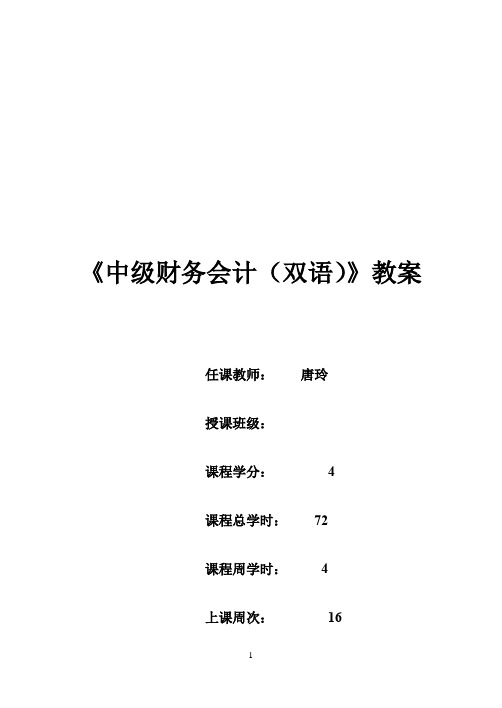
《中级财务会计(双语)》教案任课教师:唐玲授课班级:课程学分: 4课程总学时:72课程周学时: 4上课周次:16教学进度计划教学内容总学时教学手段教学环境第一章总论 4 多媒体课堂教学第二章货币与金融资产 6 多媒体课堂教学第三章应收及预付款项 4 多媒体课堂教学第四章存货 6 多媒体课堂教学第五章长期股权投资 6 多媒体课堂教学第六章固定资产8 多媒体课堂教学第七章无形资产及其他资产 4 多媒体课堂教学第八章流动负债 6 多媒体课堂教学第九章长期负债 4 多媒体课堂教学第十章所有者权益 2 多媒体课堂教学第十一章收入、费用、利润6多媒体课堂教学第十二章财务报告 6 多媒体课堂教学实习10 课堂实践合计72每节课时分配参见课程教学的基本内容。
参考书目:(一)使用教材:唐纳德.E.基索、杰里.J.韦安特著《Intermediate Accounting》中国人民大学出版社李宝珍、裴淑红编《财务会计学》中国市场出版社(二)主要参考书目:《中级会计实务》财政部会计资格评价中心编经济科学出版社《注册会计师全国统一考试辅导教材——会计》中国财政经济出版社《Financial Accounting》,沃尔特·T·小哈里森、查尔斯·T·亨格瑞,美国:清华大学出版社,课程简介中级财务会计(双语)课程是会计学专业、财务管理专业的一门专业必修课和核心课程,是会计专业知识结构中的主体部分。
本课程的任务是介绍财务会计的基本理论和实务,培养学生从事财务会计工作应具备的基本知识、基本技能和操作能力。
本课程共72学时,4.5个学分,其中62个学时为课堂讲授,10个实习课时。
通过本课程的教学,使学生能够掌握会计核算的相关知识和方法,为其进一步学习打下良好的基础。
教学中应注意对学生基本技能的培养,实现应用型人才的培养目标。
课次 1 课时 2 累计课时 2 教学目的与要求通过教学,应使学生了解该课程的内容;一般掌握理解财务会计的目标、基本假设、会计信息质量要求。
中级财务会计(双语)第二章
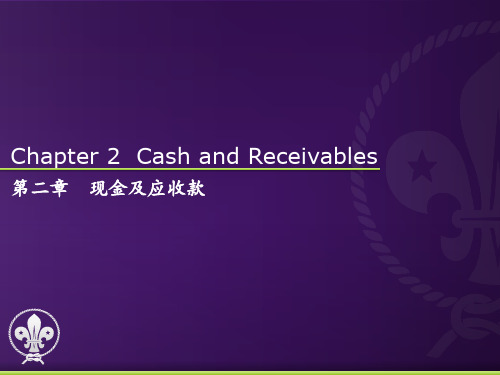
Gross Method V.S. Net Method • In America, most companies use the gross method because it’s easier than the net method. • But in China, only the gross method is allowed to use.
• Trade discounts only has one way to record: use the net price to record the accounts receivable and the revenue. • Cash discounts has two ways to record: gross method & net method.
▪ Notes receivable are supported by the note and an invoice.
• Accounts receivable are classified as current assets, because their collection period (收款期) is usually less than one year. • AR are recognized on the day when we deliver the goods/services.
Trade receivables 商业应收款: resulting from the sale of goods or services. Receivables Exp. Accounts Receivable Nontrade receivables 非商业应收款: not resulting from the sale of goods or services.
中级财务会计英文

Accounting Changes Reporting Issues & Approaches
Why are accounting changes made? New FASB pronouncements Changing economic conditions Changing internal circumstances
Continued
Retrospective Adjustment Method
3. The company adjusts the financial statements of each prior period to reflect the specific effects of applying the new accounting principle. That is, each item in each financial statement that is affected by the change is restated to the appropriate amount under the new accounting principle. The company uses the new accounting principle in its current financial statements.
distinguished from a change in accounting estimate
Changes in Accounting Principle
Three approaches for reporting changes: 1) Currently (cumulative effect). 2) Retrospectively. 3) Prospectively (in the future). 4) FASB requires use of the retrospective approach.
最新中级财务会计英文ch12课件PPT

部按照公司董事会会议确定的换股比例转换为攀钢钢钒 股份.
(600369)"ST长运"公布董监事会决
议暨召开临时股东大会公告
• 重庆长江水运股份有限公司于2007年11月21日召 开五届十次董事会及五届五次监事会,会议审议通 过如下决议: 一、通过公司重大资产出售的议案:同日,公司 与重庆市长江水运有限责任公司(下称:长运有限) 签署了《重大资产出售协议》,公司拟向长运有限 转让全部资产及负债(含或有负债),同时,公司现有 全部业务及全部职工也将随资产及负债一并由长 运有限承接,转让资产的范围最终以交割日的实际 状况为准.转让资产的价格按照公司截至转让基准 日即2007年6月30日经评估确认的净资产值确 定为人民币261.10万元.该事项构成关联交易.
月2日召开,审议通过了《Hale Waihona Puke 于攀钢钢钒吸收合并攀渝钛 业的议案》.
合并方式:同意攀枝花新钢钒股份有限公司以新增股 份吸收合并公司,攀钢钢钒为吸收方和存续方,公司为被 吸收合并方.公司全体股东所持的攀渝钛业股份将全部 按照公司董事会会议确定的换股比例转换为攀钢钢钒股 份.换股吸收合并完成后,公司的资产、负债、业务和人 员全部进入攀钢钢钒,公司将注销法人资格.
• Tender Offer:公开收购要约. 指在公开交易 市场外直接向一个公司的所有股东提出以 高于现行市价的价格购买他们所持的该公 司股票的要约。
• Amalgamation:不同种类间,或不同因素、 团体、协会、联盟或公司间联合,以形成 一个同质的整体或体系。 在美国法上, Amalgamation包含Merger与Consolidation。
•
• 新设合并(Consolidation):指两个或两 个以上的公司合并为一个新设立的公司。 即A公司与B公司合并成为C公司,A公司和 B公司解散。
双语版财务会计 第二章
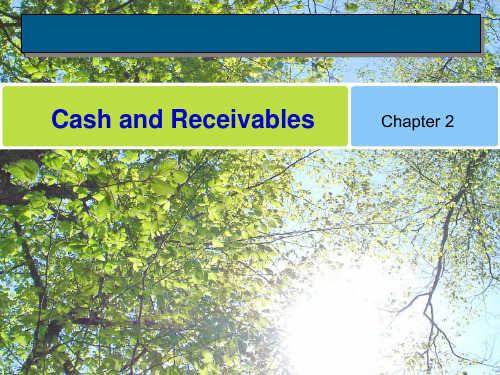
How to manage and control cash?
• It is a means by which an organization‘s resources are directed, monitored, and measured. • It plays an important role in detecting and preventing fraud(查错防弊) and protecting the organization’s resources, both – physical(实物) (e.g., machinery and property) and – intangible(无形) (e.g., reputation声誉 or intellectual property智力财产 such as trademarks商标 权).
Internal controls
• 内部控制制度是企业重要的内部管理制度,是一个单位为 了保护其资产的安全完整,保证其经营活动符合国家法律、 法规和内部规章要求,提高经营管理效率,防止舞弊,控 制风险等目的,而在单位内部采取的一系列相互联系、相 互制约的制度和方法。 • COSO委员会【1992年美国国会的“反对虚假财务报告委员 会”(NCFR)下属的由AAA、AICPA、IIA、FEI和IMA等专 业团体组织参与的“发起组织委员会(COSO)”】,1992 年发布《内部控制——基本框架》(简称COSO报告)。 • 财政部 证监会 审计署 银监会 保监会2008年印发《企业 内部控制基本规范》,2010年发布《企业内部控制配套指 引》,包括18项应用指引、1项评价指引和1项审计指引。
Cash contents
• Cash in hand, cash in bank, other monetary funds • Coin 硬币, currency • Available funds on deposit at the bank(可动用的银 行存款) • Negotiable instruments(可流通的票据) – Money orders (汇票,邮政汇票)、 certified checks (承兑支票,保付支票)、 cashier‟s checks (银行本票)、 personal checks (个人支 票)、 bank drafts (银行汇票) 、Saving accounts(定期存款)
中级财务会计chapter 4 monetary assets part2

• • • • • • • • •
(1)20×1年5月6日,购入股票: 借:可供出售金融资产——成本 l0 020 000 应收股利 l40 000 贷:银行存款 l0 160 000 (2)20×1年5月10日,收到现金股利 借:银行存款 l40 000 贷:应收股利 l40 000 (3)20×1年6月30日,确认股票的价格变动 借:可供出售金融资产——公允价值变动 380 000 • 贷:资本公积——其他资本公积 380 000
• ②20×2年12月31日 • 借:应收利息 9600 • 贷:投资收益 8886【(84000-646) ×10.66%)】 • 持有至到期投资――利息调整 714 • 收到利息时: • 借:银行存款 9600 • 贷:应收利息 9600 • ③20×3年12月31日 • 借:应收利息 9600 • 贷:投资收益 8809【(84000-646-714) ×10.66%)】 • 持有至到期投资――利息调整 791 • 收到利息时: • 借:银行存款 9600 • 贷:应收利息 9600
• (5)公允价值变动损益=(800000+900000)16.4×100000=60000(元) • 借:公允价值变动损益 60000 • 贷:交易性金融资产——A公司股票(公允价值变动) 60000 • (6)借:银行存款 1040000 • 交易性金融资产——A公司股票(公允价值变动) 36000 • 贷:交易性金融资产——A公司股票(成本) 1020000 • 投资收益 56000 • 借:投资收益 36000 • 贷:公允价值变动损益 36000 • (7)公允价值变动损益 • =18×40000-[(800000+900000-1020000)- (60000-36000)] =64000(元) • 借:交易性金融资产——A公司股票(公允价值变动) 64000 • 贷:公允价值变动损益 64000
中级财务会计英文ch13

{ Collections
on Account
=
Accrual-basis Revenues
+ Decrease in net A/R - Increase in net A/R
Outflows
Payments to purchase plant assets
Purchases of debt and equity securities
Loans to others Payments to purchase real
estate
Chapter 13-12
Cash Flows From Financing Activities
Direct Method
Inflows (3) 1. Cash from customers (A/R) 2. Cash from interest revenue (Interest Receivable) 3. Cash from dividend revenue (Dividends Rec.) 4. Outflows (5) 5. Cash paid to suppliers (A/P) 6. Cash paid for wages (Wages Payable) 7. Other cash expenses (Prepaid/Accrued) 8. Cash paid for interest expense (Interest Payable) 9. Cash paid for taxes (T/P and Deferred Tax)
Chapter 13-20
$67,000
Cash From Customers Analyzing Sales
The key information is cash collected from customers.
- 1、下载文档前请自行甄别文档内容的完整性,平台不提供额外的编辑、内容补充、找答案等附加服务。
- 2、"仅部分预览"的文档,不可在线预览部分如存在完整性等问题,可反馈申请退款(可完整预览的文档不适用该条件!)。
- 3、如文档侵犯您的权益,请联系客服反馈,我们会尽快为您处理(人工客服工作时间:9:00-18:30)。
• The net method supposes all the cash discounts can be taken. 净价法假设所有的现金折扣都可以被享受。 • But if cash discount is not taken, then put the discount amount into “interest revenue”.
Net method 净价法 • How to use net method:
① At first, use the net price to record accounts receivable. ② If the cash discount is not realized (beyond discount period), then record the discount amount as “interest revenue”.
Net price=full price – trade discount
Trade Discounts
• Exp. A company sells a machine at a price of $2,500, but sells it to a customer at list less a 10% discount. (credit sale) • Net price=full price-trade discount=$2,500$2500×10%=$2,250 • Dr. Accounts Receivable 2,250 • Cr. Sales Revenue 2,250
Cash Discounts • Cash Discounts: often called sales discounts, represent reductions not in the selling price of a good or service but in the amount to be paid by a credit customer if paid within a specified period of time. (reduction in payment) • 现金折扣:又称为销售折扣,它并不是对商品或劳务 销售价格的减少,而是对赊购客户在特定的期间内付 款而给予应付款金额的减少。(应付款的减少) • It is a discount intended to provide incentive for quick payment. (encourage customers to pay the cash as soon as possible)
Part B
Current Receivables 短期应收款ng to learn:
The classification of “Receivables”
Accounts receivable
Notes receivable
Receivables • Receivables are a company’s claims to the future collection of cash, other assets or services. 应收款是企业在未来要求收取现金、其他 资产或者服务的权利。
Exp. Interest Receivable
Accounts Receivable • Accounts receivable are coming from credit sale (赊销). • Accounts receivable are supported by the customer’s credit and an invoice.
Chapter 2 Cash and Receivables
第二章 现金及应收款
Part A
Cash and Cash Equivalents
• In this part, we are going to learn:
Cash
Cash equivalents
Cash • Cash includes currency and coins, balances in checking accounts, and items acceptable for deposit in these accounts. • 现金包括纸币、硬币、银行支票存款账户的余额以及 可以存入这些账户的款项。 • Simply, “cash”=money hold in hand + money in the bank
Gross Method V.S. Net Method • In America, most companies use the gross method because it’s easier than the net method. • But in China, only the gross method is allowed to use.
Cash Discounts • Exp. Our company offered cash discount: 2/10, n/30.
2/10, meaning a 2% discount if paid within 10 days. (10 days---discount period) n/30, meaning no discount if paid within 30 days.
Example of net method • Our company’s credit terms are stated as 2/10, n/30. On Oct. 5, 2011, we sold merchandise at a price of $20,000. The customer paid 70% of its total price on Oct. 14 and the remaining balance of $6,000 on Nov. 4.
Comparing trade discounts & cash discounts • Trade discounts are often offered to those customers who purchase goods/services in large quantity. • Cash discounts are offered to those customers who pay the cash within the discount period. • The purpose of trade discounts is to encourage large purchase. • The purpose of cash discounts is to encourage quick payment.
Gross Method V.S. Net Method
• The gross method supposes all the cash discounts can not be taken. 总价法假设所有的现金折扣都不能被 享受。 • But if cash discount is taken, then put the discount amount into “sales discounts”.
• Trade discounts only has one way to record: use the net price to record the accounts receivable and the revenue. • Cash discounts has two ways to record: gross method & net method.
Cash Equivalents
• Cash Equivalents include money market funds, treasury bills, and commercial paper. • 现金等价物包括货币市场基金、国库券和商业票据等。 • The maturity date (到期日) for cash equivalents should be no longer than three months from the date of purchase.
Comparing trade discounts & cash discounts • Trade discounts are expressed as percentage reduction from price. (exp. 20% of trade discount) • Cash discounts are expressed as terms of 2/10, n/30.
• Two ways to record cash discounts:
Gross method Net method
Gross method 总价法 • How to use gross method:
① At first, use the full price to record accounts receivable. ② If the cash discount is realized (within discount period), then put the discount amount into “sales discount”.
Trade receivables 商业应收款: resulting from the sale of goods or services. Receivables Exp. Accounts Receivable Nontrade receivables 非商业应收款: not resulting from the sale of goods or services.
Initial Valuation of Accounts Receivable 应收账款的初始计量
